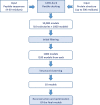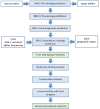A comprehensive in silico analysis for identification of therapeutic epitopes in HPV16, 18, 31 and 45 oncoproteins
- PMID: 30356257
- PMCID: PMC6200245
- DOI: 10.1371/journal.pone.0205933
A comprehensive in silico analysis for identification of therapeutic epitopes in HPV16, 18, 31 and 45 oncoproteins
Abstract
Human papillomaviruses (HPVs) are a group of circular double-stranded DNA viruses, showing severe tropism to mucosal tissues. A subset of HPVs, especially HPV16 and 18, are the primary etiological cause for several epithelial cell malignancies, causing about 5.2% of all cancers worldwide. Due to the high prevalence and mortality, HPV-associated cancers have remained as a significant health problem in human society, making an urgent need to develop an effective therapeutic vaccine against them. Achieving this goal is primarily dependent on the identification of efficient tumor-associated epitopes, inducing a robust cell-mediated immune response. Previous information has shown that E5, E6, and E7 early proteins are responsible for the induction and maintenance of HPV-associated cancers. Therefore, the prediction of major histocompatibility complex (MHC) class I T cell epitopes of HPV16, 18, 31 and 45 oncoproteins was targeted in this study. For this purpose, a two-step plan was designed to identify the most probable CD8+ T cell epitopes. In the first step, MHC-I and II binding, MHC-I processing, MHC-I population coverage and MHC-I immunogenicity prediction analyses, and in the second step, MHC-I and II protein-peptide docking, epitope conservation, and cross-reactivity with host antigens' analyses were carried out successively by different tools. Finally, we introduced five probable CD8+ T cell epitopes for each oncoprotein of the HPV genotypes (60 epitopes in total), which obtained better scores by an integrated approach. These predicted epitopes are valuable candidates for in vitro or in vivo therapeutic vaccine studies against the HPV-associated cancers. Additionally, this two-step plan that each step includes several analyses to find appropriate epitopes provides a rational basis for DNA- or peptide-based vaccine development.
Conflict of interest statement
The authors have declared that no competing interests exist.
Figures



Similar articles
-
Identification of immunotherapeutic epitope of E5 protein of human papillomavirus-16: An in silico approach.Biologicals. 2015 Sep;43(5):344-8. doi: 10.1016/j.biologicals.2015.07.002. Epub 2015 Jul 26. Biologicals. 2015. PMID: 26212000
-
Designing of Epitope-Focused Vaccine by Targeting E6 and E7 Conserved Protein Sequences: An Immuno-Informatics Approach in Human Papillomavirus 58 Isolates.Interdiscip Sci. 2018 Jun;10(2):251-260. doi: 10.1007/s12539-016-0184-5. Epub 2016 Sep 17. Interdiscip Sci. 2018. PMID: 27640170
-
T-helper epitopes identified within the E6 transforming protein of cervical cancer-associated human papillomavirus type 16.Viral Immunol. 1999;12(4):297-312. doi: 10.1089/vim.1999.12.297. Viral Immunol. 1999. PMID: 10630789
-
In silico analysis of MHC-I restricted epitopes of Chikungunya virus proteins: Implication in understanding anti-CHIKV CD8(+) T cell response and advancement of epitope based immunotherapy for CHIKV infection.Infect Genet Evol. 2015 Apr;31:118-26. doi: 10.1016/j.meegid.2015.01.017. Epub 2015 Jan 31. Infect Genet Evol. 2015. PMID: 25643869
-
Identification of the impact on T- and B- cell epitopes of human papillomavirus type-16 E6 and E7 variant in Southwest China.Immunol Lett. 2017 Jan;181:26-30. doi: 10.1016/j.imlet.2016.09.013. Epub 2016 Sep 28. Immunol Lett. 2017. PMID: 27693214
Cited by
-
Comparison of HIV-1 Vif and Vpu accessory proteins for delivery of polyepitope constructs harboring Nef, Gp160 and P24 using various cell penetrating peptides.PLoS One. 2019 Oct 31;14(10):e0223844. doi: 10.1371/journal.pone.0223844. eCollection 2019. PLoS One. 2019. PMID: 31671105 Free PMC article.
-
Immunoinformatics studies of heat shock proteins 27 and 70: Development of potent therapeutic vaccine constructs against human papillomavirus-related cancers.Heliyon. 2023 Aug 21;9(8):e19261. doi: 10.1016/j.heliyon.2023.e19261. eCollection 2023 Aug. Heliyon. 2023. PMID: 37664744 Free PMC article.
-
Novel prophylactic and therapeutic multi-epitope vaccine based on Ag85A, Ag85B, ESAT-6, and CFP-10 of Mycobacterium tuberculosis using an immunoinformatics approach.Osong Public Health Res Perspect. 2024 Aug;15(4):286-306. doi: 10.24171/j.phrp.2024.0026. Epub 2024 Jul 26. Osong Public Health Res Perspect. 2024. PMID: 39091165 Free PMC article.
-
Therapeutic DNA Vaccines against HPV-Related Malignancies: Promising Leads from Clinical Trials.Viruses. 2022 Jan 25;14(2):239. doi: 10.3390/v14020239. Viruses. 2022. PMID: 35215833 Free PMC article. Review.
-
In Silico Design and Immunological Studies of Two Novel Multiepitope DNA-Based Vaccine Candidates Against High-Risk Human Papillomaviruses.Mol Biotechnol. 2021 Dec;63(12):1192-1222. doi: 10.1007/s12033-021-00374-z. Epub 2021 Jul 25. Mol Biotechnol. 2021. PMID: 34308516
References
MeSH terms
Substances
LinkOut - more resources
Full Text Sources
Other Literature Sources
Research Materials

